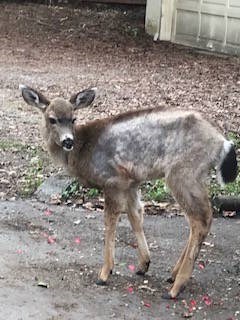Some yearling black-tailed deer are suffering from what officials are calling “winter kill,” an often fatal condition caused by a combination of parasites, poor nutrition and late births.
The B.C. Conservation Officer Service has been answering calls around the capital region about deer that look emaciated and weak and are losing their hair.
The service is warning the public not to feed them because grains, apples and other foods will impede their digestive systems and speed their demise, says conservation officer Scott Norris.
“High-sugar foods and foods they don’t eat through natural browsing and grazing will only make their conditions worse,” he said.
“Some will recover, some won’t. It happens on the South Island and I would say this is a typical year for this.”
Norris said the sickly deer are often found along fences and in yards or porches trying to keep warm. There is often evidence of diarrhea on the ground or coatings in the tail area.
Helen Schwantje, a wildlife veterinarian with the Environment Ministry, said winter kill is increasingly common during late winter and early spring in urban areas.
Deer that live on the coast are born over a longer period, which means some fawns are still small as winter approaches, Schwantje said in a report.
When they live in urban habitats with farmland, lawns and gardens, and golf courses, they feed on vegetation that may not provide proper nutrition, she said.
“Even if their nutrition was the very best, any animal entering the most nutritionally stressful time of the year [winter] at a small size will be highly stressed,” said Schwantje. “These small deer must not only maintain their weight when the weather is cold, wet and windy, using large amounts of energy, but also invest energy in growing muscle and bone.”
She said several species of ticks, lice and internal parasites normally present in deer populations can increase in a highly stressed young animal. The parasites and nutritional challenges can be enough to push struggling young deer “over the edge.”
Norris said it’s natural that people want to help the deer because they look like they are starving, but he said the right thing to do is to leave them be.
Schwantje said that by feeding the deer, “you may be killing them with kindness.”
“They cannot adjust to and digest feeds that they are not used to, and the result can be diarrhea, impaction [severe constipation] and a worse situation than before,” she said. “Both parasites and improper feeds — too rich or too sudden a change — can start the diarrhea, weight loss and other metabolic changes that can end in emaciation and death.”
Once they are in that state, deer cannot be medicated into health, she said. Many die as a result of hypothermia, hypoglycemia or exhaustion.
Norris also issued a reminder that as the new fawn season approaches later this month and into May and June, the animals should be left alone. Mother deer often leave their fawns for several hours at a time while they venture out to feed, he said.



